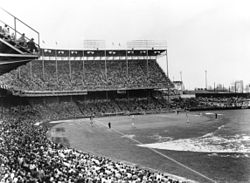 First Athletics home game in 1955 | |
Location in Missouri | |
| Former names | Muehlebach Field (1923–1937) Ruppert Stadium (1937–1943) Blues Stadium (1943–1954) |
|---|---|
| Location | 2123 Brooklyn Avenue Kansas City, Missouri |
| Coordinates | 39°05′13″N94°33′29″W / 39.087°N 94.558°W |
| Owner | City of Kansas City |
| Operator | City of Kansas City |
| Capacity | 17,476 (1923–1955) 30,296 (1955–1961) 34,165 (1961–1969) 34,164 (1969–1971) 35,561 (1971–1972) |
| Field size | 1923 Left Field – 350 ft (107 m) Center F. – 450 ft (137 m) Right Field – 350 ft (107 m) 1972 Left Field – 369 ft (112 m) L. Center – 408 ft (124 m) Center F. – 421 ft (128 m) R. Center – 382 ft (116 m) Right Field – 338 ft (103 m) |
| Surface | Natural grass |
| Construction | |
| Broke ground | 1923 |
| Opened | July 3, 1923 April 12, 1955 |
| Closed | October 4, 1972 |
| Demolished | 1976 |
| Construction cost | $400,000 |
| Architect | Osborn Engineering |
| Main contractors | Del E. Webb Construction Company, 1955 |
| Tenants | |
| Kansas City Blues (AA) (1923–1954) Kansas City Monarchs (NNL / NAL) (1923–1931, 1937–1955) Kansas City Blues / Cowboys (NFL) (1924–1926) Kansas City Athletics (MLB) (1955–1967) Kansas City Chiefs (AFL / NFL) (1963–1971) Kansas City Spurs (NASL) (1968–1969) Kansas City Royals (MLB) (1969–1972) | |
Kansas City Municipal Stadium was an American baseball and football stadium in the central United States, located in Kansas City, Missouri. It was located at the corner of Brooklyn Avenue and E. 22nd Street.
Contents
- Early stadium history
- Rebuilding for Major League Baseball – 1955
- Pre-1955 teams
- Kansas City Monarchs
- Jackie Robinson
- Kansas City Blues – Minor League
- Major League Baseball
- Kansas City Athletics
- Kansas City Royals
- American Football League/National Football League
- Kansas City Chiefs
- Longest NFL game played
- North American Soccer League
- Kansas City Spurs
- Other events
- 1960 Major League Baseball All Star Game
- 1964 Beatles concert
- Demolition and the site today
- See also
- References
- External links
Municipal Stadium hosted both the minor-league Kansas City Blues of the American Association and the Kansas City Monarchs of the Negro leagues from 1923 to 1955.
The stadium was almost completely rebuilt prior to the 1955 baseball season when the Kansas City Athletics moved to Kansas City from Philadelphia. The Athletics played from 1955 to 1967, the Kansas City Royals from 1969 to 1972, the Kansas City Chiefs (American Football League and National Football League) from 1963 to 1971 and the Kansas City Spurs (North American Soccer League) from 1968 to 1969.
The stadium hosted the Major League Baseball All-Star Game in 1960 (first game). In the final football game played there, Municipal Stadium was the site of the longest NFL game in history, a playoff game between the Chiefs and the Miami Dolphins on Christmas Day 1971; the Chiefs moved to the new Arrowhead Stadium in 1972. Jackie Robinson played at the stadium for the Kansas City Monarchs in 1945 until he was signed by the Brooklyn Dodgers.









